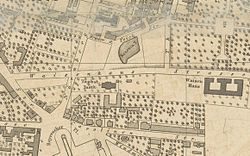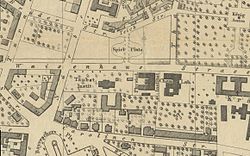Kanonenteich (Leipzig)
The Kanonenteich was a pond that existed until around 1870 in the south-eastern suburb of Leipzig . It probably got its name in connection with the Battle of the Nations near Leipzig .
location
The cannon pond was located in the area of today's green area between Brüderstraße, Talstraße and Liebigstraße, east of the Anatomical Institute of the University of Leipzig. At the time of its existence the deaf-mute institute existed south of it on Waisenhausstrasse (today Liebigstrasse) and east of this the orphanage, later St. Jacob Hospital . The allotment gardens of the Johannistal were connected to the pond in the east via Talstrasse, the poor school in the north, later the 1st district school.
history
Until the beginning of the 19th century, there was a large sand pit on the site of the Johannistal southeast of the city, which belonged to the property of the Johannishospital . (See map from 1802) This is also indicated by the Sandgasse leading in this direction (from 1839 Ulrichgasse, from 1891 Seeburgstrasse) and at the end of it the Sandtor , an outer city gate. In the apparently unregulated sand mining, individual water areas formed (Map 1802). When allotment gardens were laid out in the Johannistal valley at the beginning of the 19th century on the initiative of Moritz Seeburg city council , a larger area of water remained in the western part than a pond.
For the Battle of Nations on October 19, 1813, bitter fighting took place in the area around this pond. It is not known whether, as allegedly reported, cannons were sunk here (diving tests did not produce any results) or other contexts played a role in the naming of the pond; In any case, the pond was popularly called the cannon pond in the following . Until 1885 the street that passed it was called Teichstraße , then until today it was called Brüderstraße .
For the 1860s Kutschbach reports bad smells emanating from the pond, and in the second half of the 1860s the pond was filled in (see maps 1864 and 1871). A playground was set up and a green area was created in which a Samuel Heinicke memorial was erected in 1881 .
In 1879/1980 a new building for the deaf institute was built on the upper part of the site, at the corner of Liebig and Talstrasse, and the university's mineralogical institute moved into it in 1916. The building was destroyed in the war in 1943 and was never rebuilt.
In connection with the construction of the anatomical institute, the green area was redesigned and placed under monument protection. Although the cannon pond has a long history, its name is still alive. The playground in the green area is called "Kanonenteich playground" in the list of Leipzig playgrounds.
literature
- Adolf Lippold: Of night watchmen, junk Jews and harp girls . Lehmstedt-Verlag 2004
- Friedrich Richter: History of the German War of Freedom from 1813 to 1815 , Vol. 2, Berlin 1837 ( online )
- Albin Kutschbach: The Prussians are here. ( online ) From: Youth memories of an old Leipziger , Leipzig, Timm, 1926
Individual evidence
- ↑ Horst Riedel: Stadtlexikon Leipzig from A to Z . PRO LEIPZIG, Leipzig 2005, ISBN 3-936508-03-8 , p. 274
- ^ Gina Klank, Gernot Griebsch: Lexikon Leipziger Straßeennamen , Verlag im Wissenschaftszentrum Leipzig, 1995, ISBN 3-930433-09-5 , p. 195
- ^ Richter: History of the German War of Freedom , p. 310
- ↑ a b Kutschbach: The Prussians are here
- ↑ List of cultural monuments in Leipzig-Zentrum-Südost , ID number 09304397
- ↑ Kanonenteich playground
Coordinates: 51 ° 19 '55.3 " N , 12 ° 23' 2.8" E







